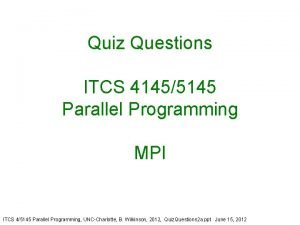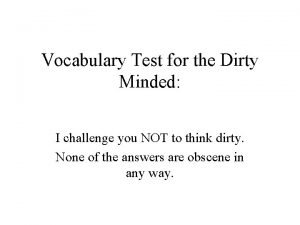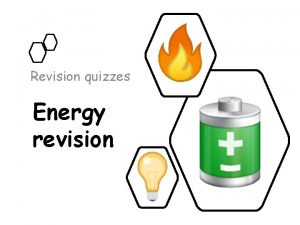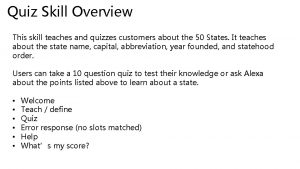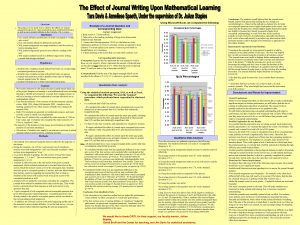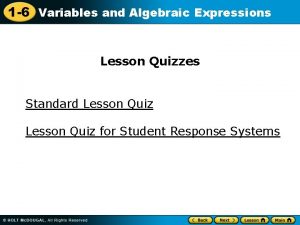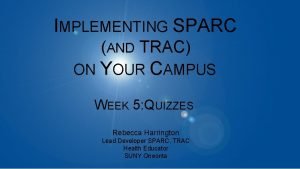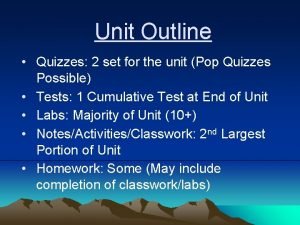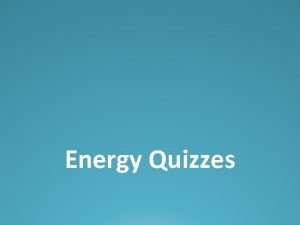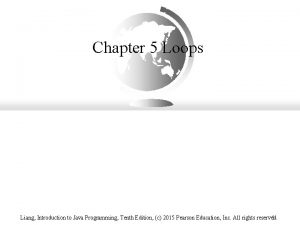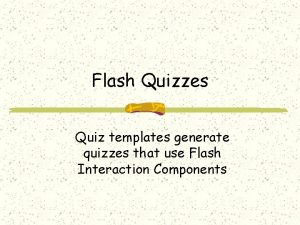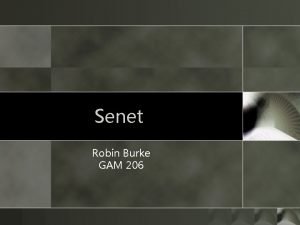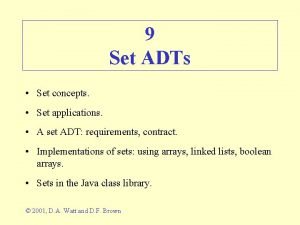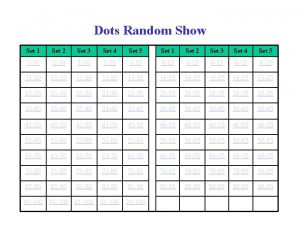Unit Outline Quizzes 2 set for the unit















































































































- Slides: 111

Unit Outline • Quizzes: 2 set for the unit (Pop Quizzes Possible) • Tests: 1 Cumulative Test at End of Unit • Labs: Majority of Unit (10+) • Notes/Activities/Classwork: 2 nd Largest Portion of Unit • Homework: Some (May include completion of classwork/labs)

Meteorology The Study of the Earth’s atmosphere

WEATHER • The state of the atmosphere at a given time.

Atmospheric Variables • Air Temperature: measure of average kinetic energy of molecules. • Instrument: Thermometer • Units: °Celsius, (Fahrenheit – U. S. ) • Affected by insolation, cloud cover.

Atmospheric Variables • Wind: horizontal movement of air. • Instruments: anemometer (for speed) • wind vane (direction: N, S, E, W) • Units: miles/hour, km/hr

Homemade Anemometer

Wind Vane

Atmospheric Variables • • Air Pressure: weight of the atmosphere Instrument: barometer Units: Inches of mercury or millibars Affected by: elevation, temperature, storms.

Barometer: Air Pressure

Atmospheric Variables • Humidity: measure of the amount of moisture in the air. • Instrument: Sling psychrometer • Units: % (for relative humidity) • Affected by: temperature, air pressure, rate of evaporation.

Sling Psychrometer

Humidity • Absolute Humidity: The Amount of water vapor in the air. • Relative Humidity: Comparison between the amount of water vapor in the air and the amount of water vapor the air is capable of holding.

Humidity • Evaporation: moisture (water vapor) enters the air and cools the atmosphere. • Condensation: water vapor leaves the air, warming the atmosphere. • As the temperature increases, the rate of evaporation increases.

Air Capacity • ***Warm air tends to hold more moisture than cold air*** • For Condensation to occur: • Air must be saturated with water vapor. • What does saturated mean? • Air must contain condensation nuclei (dust, pollen, aerosols).

Dewpoint Temperature • Temperature at which air becomes saturated with water vapor • Water vapor condenses to a liquid. • The closer the air temperature and dewpoint temperature, the greater the relative humidity AND the greater the chance of precipitation.

Relative Humidity can be changed in two ways • 1. Increase the amount of moisture in the atmosphere. • 2. Decrease the air temperature.


Partial Relative Humidity for 30 o. C Difference Between Dry Bulb and Wet Bulb Temperatures Relative Humidity None ? 0. 5° 96% 1. 0° 93% 1. 5° 89% 9. 0° 44% 9. 5° 42% 14. 5° 19% 15. 0° 17%

Finding Dewpoint using the ESRT • 1. Find the dry bulb (air) temperature • 2. Find the wet bulb temperature • 3. Subtract the dry and wet bulb temperatures to find the wet bulb depression • 4. On the Chart: look up the dry bulb temperature on the left hand side. • 5. On the chart: look up the wet bulb depression (difference between dry & wet bulb) on the top • 6. Find where the two intersect in the chart to find the dewpoint temperature

ESRT p. 12

Try These (find the Dewpoint Temperature) • A. The dry bulb temperature is 24°C and the wet bulb is 14°C • B. The Dry bulb is 20°C and the wet bulb is 15°C

Finding Relative Humidity with ESRT • 1. Find the dry bulb or air temperature • 2. Find the wet bulb temperature • 3. Subtract the dry and wet bulb temperatures to find the wet bulb depression • 4. On the Chart: look up the dry bulb temperature on the left hand side. • 5. On the chart: look up the wet bulb depression (difference between dry & wet bulb) on the top • 6. Find where the two intersect in the chart to find the relative humidity

ESRT p. 12

Try These (Find the Relative Humidity) • C. The dry bulb temperature is 24°C and the wet bulb is 14°C • D. The Dry bulb is 20°C and the wet bulb is 15°C

Dew Point Explained

Video

Find the Relative Humidity for Syracuse Right Now http: //forecast. weather. gov/Map. Click. php? City. Name=Syracuse&state=NY&site=BG M&lat=43. 0446&lon=76. 1459#. WJsj. VVMr. Kzc

Practice 1. Find the Wet Bulb Depression a. Same as difference between dry and wet bulb. 2. Use the Air Temperature (Dry Bulb) and the Wet Bulb Depression to find the Dew Point and Relative Humidity.

Dew point Activity

Discussion As you go further up in our atmosphere (like the top of mountain), does it get colder or warmer? Why?

Video

Layers of the Atmosphere

Ozone •

Bad Ozone • “Bad ozone, ” also known as ground level ozone, when ozone is present in troposphere, is an air pollutant – Commonly referred to as “Smog” – Harmful to reparatory systems of humans and animals and negatively affects other living organisms • Not directly emitted by human activity, but reaction with sunlight and emissions cause ground level ozone to form

Layers of the Atmosphere (p. 14)

Layers of Atmosphere


Cloud Formation • Condensation of water vapor when air cools to the dewpoint temperature and condensation nuclei are present. • Condensation Nuclei: Any surface that a drop of water can land on (ex. dust).

Clouds form when air rises Air Rises because: 1) Convection: Warm air rises because it is less dense. 2) Air is moving over a mountain. As air rises, it cools, reaches its dewpoint temperature, and water vapor condenses, forming a cloud. Cool air becomes saturated.

Cloud Formation

Cloud Formation above a mountain

Cloud Classifications • Altitudes: High (Cirrus), Middle (Alto) and Low. • Forms: • Stratus: A layer of clouds. • Cumulus: Large puffy clouds with height. • Nimbo: Storm cloud, usually gray.

Types of Clouds

Cloud Types

Precipitation • Water droplets become too heavy, and start to drop. • Rain: water droplet • Sleet: frozen water droplet • Snow: Ice crystals • Hail: layers of frozen water formed in storm clouds.

Adiabatic Temperature Changes • Result of rising or sinking air.

Video

Determining Cloud Base Altitude (Skip conditions in class and outside)

Air Pressure (barometric pressure) • Standard Air Pressure (at sea level): • 29. 92 inches of mercury, 1013. 2 millibars

(Aneroid Barometer)

POE 1. Predict, Observe, Explain a. What do you think happens to an astronaut in space when the space station door is opened? b. Watch Video c. What actually happened 2. Two apples on strings with air going between them.

Space Vacuum Video Interstellar - 2: 05: 00

Warm Air vs. Cold Air

Low Pressure (L) • The air is warmer, and also less dense, rises. • The air moves up, inward, and turns counterclockwise (Coriolis Effect) L

High Pressure (H) • The air is colder, and more dense, sinks. • Air moves down, outward, and is turned clockwise. H

Convergence and Divergence As a group: Come up with a definition of convergence and divergence in terms of weather.

Coriolis Effect • Objects are deflected due to Earth’s rotation.

Coriolis Effect

Coriolis Effect Video https: //www. youtube. com/watch? v=i 2 mec 3 vgea. I

Air Masses • Large bodies of air with uniform (the same) temperature, moisture content, and air pressure throughout. • Characteristics depend on where they develop. • Continental (C): Dry air, formed above land. • Maritime (M): Wet air, formed above oceans.

Air Mass

Air Mass Descriptions Region of Origin Characteristics Symbol Air Mass c. A continental arctic N Canada Cold, very dry c. P continental polar Canada Cold/Dry m. P Maritime polar N Pacific or Atlantic Cold/Wet c. T Continental tropical SW Mexico Hot/Dry m. T Maritime tropical Gulf of Mexico, S Warm/wet Pacific

Air Mass Movement

Fronts (Separating Air Masses) • Frontal Boundaries: Where changes in temperature, air pressure, humidity, and wind direction occur.

Warm Front • A mass of warm air moves into an area of cooler air (slow-moving). • High, thin, wispy clouds • Long periods of light precipitation • Air Pressure decreases • Temperature and humidity increase

Warm Front

Cold Front • A mass of cold air moves into an area of warmer air (fast-moving). • Tall cumulus clouds • Change in wind direction, increase speed. • Heavy, brief period of rain. • Possible thunder storms, increase in air pressure. • Decrease in temperature and humidity.

Cold Front

Stationary Front • Two adjacent air masses with different characteristics are at a standstill. • Weather is similar to a warm front. • Stationary Fronts develop into Low pressure systems.

Stationary Front

Occluded Front • Formed when a cold front catches up with a warm front. • Warm air is forced up off the ground. • Associated with Low pressure systems. • Heavy Rain or Snow (if in winter)

Occluded Front

Relationships Between Atmospheric Variables • Air Temperature Vs. Air Pressure • Colder Air is more dense than warm air • As air temperature increases, pressure decreases.

Air Temp VS Humidity • Warm air can hold more moisture than cold air. It’s like a bigger sponge. • LP = warm and wet weather

Air Pressure VS. Humidity • Low pressure systems have higher humidity • As humidity increases, air pressure decreases.

Altitude VS Air Temperature/Pressure • Altitude: Height above Sea Level • As altitude increases, temperature decreases. • As altitude increases, air pressure decreases.

Air Temperature and Dewpoint • The closer these numbers are, the greater the chance of precipitation. • Example: Which location has a greater chance of rain today? • 1) Buffalo: Temp = 54°, Dewpoint = 52° • 2) Syracuse: Temp = 53°, Dewpoint = 45°

Turn and Talk 1. How is wind related to pressure? 2. How is pressure related to heat? 3. Does the Sun heat the Earth evenly or unevenly, why?

Wind Convection Video

Anemometer

Winds • Winds always move from areas of HIGH pressure to areas of LOW pressure. • The greater the difference in air pressure, the faster the wind.

Sea Breeze (Daytime) • The specific heat of land is less than the specific heat of water. • During the day, land heats up faster, LOW pressure develops. • The water is cooler, and the air above it has a HIGH pressure. • Wind moves from the water toward land.

Sea Breeze (Daytime)

Land Breeze at Night • • Land cools off faster at night. High pressure develops over land. Water is warmer, low pressure. Winds move from the land toward the water.

Land Breeze (at night)

World Winds • At the Equator: insolation is greatest - warm temperatures - Low pressure • Convergence Zone: Hadley Cells • At 30° Latitude: Air from the equator has cooled in upper atmosphere and begins to sink - high sunny, Deserts). pressure (Dry,

It’s all about the relative specific heats.

Windward Leeward Video • http: //study. com/academy/lesson/the-rainshadow-effect-definition-lesson-quiz. html • https: //www. youtube. com/watch? v=b 4 D 1 TL 2 psd. E

Complete World Pressure and Wind Belts 1. Use page 14 in the ESRT to complete the wind directions on the Earth

Website https: //www. windyty. com/? pressure, 201601 -13 -12, 43. 173, -74. 333, 6

World Pressure and Wind Belts

Wind Belts with Coriolis Effect

• At 30° Latitude: Air from the equator has cooled in upper atmosphere and sinks - high pressure (Dry, sunny, Deserts).

Prevailing Wind Belts

Ocean Currents http: //oceanservice. noaa. gov/facts/current. html


1. 2. 3. 4. Create a Continent Draw a shape of a fictional continent. Write or draw the scale 1 inch = 1000 km Draw an equator in green. On the bottom, draw an arrow pointing right. (Direction of Earth’s rotation) 5. Draw two red lines parallel to the equator, 2 inches above and 2 below the equator 6. Label inside these lines “High Pressure Zone” 7. Grab a rubber band for your mountain ranges. 8. Take a penny to draw a lakes and natural resources. 9. Draw wind directions in yellow (based on the notes) 10. Based on location (where the equator is), label the biomes: desert, aquatic, forest, grassland, tundra. 11. Explain why you put the biomes where you did.

Isoline Lab • Isolines, Isobars, Isotherms • Map A – Draw 13, 17, 19, 21, 23 degree isotherms – Answer the questions • Map B – Draw 10, 20, 30, 40, 50, 60, 70 degree isotherms – Answer the questions • Map C – Draw 1000, 1004, 1008, 1012, 1016, 1020, 1024 isobars – Answer the questions • Map D – Draw 996, 1000, 1004, 1008, 1012, isobars – Answer the questions

Map A

Map B

Map C

Map D

Cyclones 1. Has anyone heard of a cyclone? Where or how? 2. Raise your hand if you have been in a hurricane or have family members that have been.

Cyclone - a large-scale, atmospheric windand-pressure system characterized by low pressure at its center and by circular wind motion, counterclockwise in the Northern Hemisphere (tropical storms, typhoons, twisters, hurricanes) Anticyclone - a circulation of winds around a central region of high atmospheric pressure, clockwise in the Northern Hemisphere.

Videos/Interactives https: //www. scholastic. com/teachers/activities/ teaching-content/weather-and-climate-13 studyjams-interactive-science-activities/ Airmass http: //studyjams. scholastic. com/studyjams/jam s/science/weather-and-climate/air-masses-andfronts. htm Cloud – http: //studyjams. scholastic. com/studyjams/jam s/science/weather-and-climate/clouds-andprecipitation. htm

Air pressure and wind – http: //studyjams. scholastic. com/studyjams/jam s/science/weather-and-climate/clouds-andprecipitation. htm Severe storms – http: //studyjams. scholastic. com/studyjams/jam s/science/weather-and-climate/severestorms. htm Weather Instrumentshttp: //studyjams. scholastic. com/studyjams/jam s/science/weather-and-climate/weatherinstruments. htm

• Air masses/Fonts – https: //www. youtube. com/watch? v=d. BNIVzb 0 sds • Wind - https: //www. youtube. com/watch? v=2 nh. O 30 D 5 DSY • Wind Belts - ESRT pg 14 https: //www. youtube. com/watch? v=k. Pue. XIHGQrg https: //www. youtube. com/watch? v=o. Cdq. Gkn-B 1 E

Weather and Climate Review • Part 1 - https: //www. youtube. com/watch? v=d. IWy 0 _DAg. JU • Part 2 - https: //www. youtube. com/watch? v=Mzt. Kg Skg 3 Dc

Millionaire • http: //www. regentsearthscience. com/in dex. php? option=com_wrapper&view= wrapper&Itemid=56 • https: //www. superteachertools. us/millionai re/millionaire. php? gamefile=39895 • https: //www. superteachertools. us/millionai re/millionaire. php? gamefile=27231

Jeopardy https: //www. playfactile. com/my. Games http: //www. regentsearthscience. com/jeopardy/m eteorology/jeopardy. htm https: //jeopardylabs. com/play/meteorology 13 https: //jeopardylabs. com/play/meteorology 110 https: //jeopardylabs. com/play/meteorology 45 https: //jeopardylabs. com/play/meteorology 154

KAHOOT https: //create. kahoot. it/l/#user/9 8 b 2 ef 58 -6309 -4 a 80 -b 00 af 917 c 912 abe 9/kahoots/favourite s
 Total set awareness set consideration set
Total set awareness set consideration set Training set validation set test set
Training set validation set test set Jlab quizzes
Jlab quizzes Mpi quizzes
Mpi quizzes Fft quiz
Fft quiz Night chapter 2 quiz
Night chapter 2 quiz Quizzes
Quizzes Dirty mind test
Dirty mind test Https://www.tate.org.uk/kids/games-quizzes/street-art
Https://www.tate.org.uk/kids/games-quizzes/street-art Quizzes
Quizzes Quizzes
Quizzes Weighfair
Weighfair Frankenstein letters quiz
Frankenstein letters quiz Quizzes for students
Quizzes for students Holes chapter 1-5 quiz
Holes chapter 1-5 quiz Quizzes
Quizzes Evaluating algebraic expressions quiz
Evaluating algebraic expressions quiz Sparc quiz answers
Sparc quiz answers Moodle quizzes
Moodle quizzes Quizzes
Quizzes No quiz today
No quiz today Neprhon
Neprhon The odyssey book 1 quiz
The odyssey book 1 quiz Happy monday answer key
Happy monday answer key Phys 241 purdue
Phys 241 purdue How to change fraction to decimal
How to change fraction to decimal Quizzes
Quizzes Quizzes
Quizzes Introduction to java programming 10th edition quizzes
Introduction to java programming 10th edition quizzes Paragraph sandwich example
Paragraph sandwich example Bounded set vs centered set
Bounded set vs centered set Fuzzy logic
Fuzzy logic Crisp set vs fuzzy set
Crisp set vs fuzzy set Crisp set vs fuzzy set
Crisp set vs fuzzy set What is the overlap of data set 1 and data set 2?
What is the overlap of data set 1 and data set 2? Surjective vs injective
Surjective vs injective Fspos
Fspos Typiska novell drag
Typiska novell drag Tack för att ni lyssnade bild
Tack för att ni lyssnade bild Vad står k.r.å.k.a.n för
Vad står k.r.å.k.a.n för Shingelfrisyren
Shingelfrisyren En lathund för arbete med kontinuitetshantering
En lathund för arbete med kontinuitetshantering Underlag för särskild löneskatt på pensionskostnader
Underlag för särskild löneskatt på pensionskostnader Personlig tidbok
Personlig tidbok Anatomi organ reproduksi
Anatomi organ reproduksi Vad är densitet
Vad är densitet Datorkunskap för nybörjare
Datorkunskap för nybörjare Stig kerman
Stig kerman Debattartikel struktur
Debattartikel struktur Magnetsjukhus
Magnetsjukhus Nyckelkompetenser för livslångt lärande
Nyckelkompetenser för livslångt lärande Påbyggnader för flakfordon
Påbyggnader för flakfordon Kraft per area
Kraft per area Publik sektor
Publik sektor Kyssande vind
Kyssande vind Presentera för publik crossboss
Presentera för publik crossboss Vad är ett minoritetsspråk
Vad är ett minoritetsspråk Kanaans land
Kanaans land Klassificeringsstruktur för kommunala verksamheter
Klassificeringsstruktur för kommunala verksamheter Fimbrietratt
Fimbrietratt Bästa kameran för astrofoto
Bästa kameran för astrofoto Centrum för kunskap och säkerhet
Centrum för kunskap och säkerhet Lågenergihus nyproduktion
Lågenergihus nyproduktion Bra mat för unga idrottare
Bra mat för unga idrottare Verktyg för automatisering av utbetalningar
Verktyg för automatisering av utbetalningar Rutin för avvikelsehantering
Rutin för avvikelsehantering Smärtskolan kunskap för livet
Smärtskolan kunskap för livet Ministerstyre för och nackdelar
Ministerstyre för och nackdelar Tack för att ni har lyssnat
Tack för att ni har lyssnat Referat mall
Referat mall Redogör för vad psykologi är
Redogör för vad psykologi är Borstål, egenskaper
Borstål, egenskaper Tack för att ni har lyssnat
Tack för att ni har lyssnat Borra hål för knoppar
Borra hål för knoppar Orubbliga rättigheter
Orubbliga rättigheter Fr formel
Fr formel Tack för att ni har lyssnat
Tack för att ni har lyssnat Steg för steg rita
Steg för steg rita Verksamhetsanalys exempel
Verksamhetsanalys exempel Tobinskatten för och nackdelar
Tobinskatten för och nackdelar Toppslätskivling dos
Toppslätskivling dos Mästare lärling modell
Mästare lärling modell Egg för emanuel
Egg för emanuel Elektronik för barn
Elektronik för barn Fredsgudinnan
Fredsgudinnan Strategi för svensk viltförvaltning
Strategi för svensk viltförvaltning Kung dog 1611
Kung dog 1611 Humanitr
Humanitr Ro i rom pax
Ro i rom pax Tack för att ni lyssnade
Tack för att ni lyssnade Avrunda decimaltal
Avrunda decimaltal Upprepningar i prosa
Upprepningar i prosa Inköpsprocessen steg för steg
Inköpsprocessen steg för steg Rbk mätning
Rbk mätning Ledarskapsteorier
Ledarskapsteorier Kolposkopi, px
Kolposkopi, px Myndigheten för delaktighet
Myndigheten för delaktighet Trög för kemist
Trög för kemist Tillitsbaserad ledning
Tillitsbaserad ledning Läkarutlåtande för livränta
Läkarutlåtande för livränta Tät skog karttecken
Tät skog karttecken Geometriska former i förskolan
Geometriska former i förskolan Vishnuiter
Vishnuiter Vad är vanlig celldelning
Vad är vanlig celldelning Bris för vuxna
Bris för vuxna Bamse för de yngsta
Bamse för de yngsta Hình ảnh bộ gõ cơ thể búng tay
Hình ảnh bộ gõ cơ thể búng tay Bổ thể
Bổ thể Tỉ lệ cơ thể trẻ em
Tỉ lệ cơ thể trẻ em Gấu đi như thế nào
Gấu đi như thế nào Glasgow thang điểm
Glasgow thang điểm



